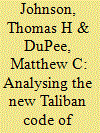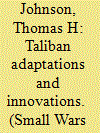| Srl | Item |
| 1 |
ID:
110792


|
|
|
|
|
| Publication |
2012.
|
| Summary/Abstract |
Periodically, Afghanistan's Taliban leadership formally issues Layeha or 'codes of conduct' for their fighters and supporters. Layeha offer important insights into the Afghan Taliban's objectives, strategies and the psyche/perspective of Taliban leadership. This article presents an analysis of the Taliban's code of conduct and examines what Layeha tell us about Taliban objectives, strategy and organization. Such information would seem particularly important as the United States as well as its coalition allies assess their Afghan operational strategy as well as exit strategy from Afghanistan. This analysis of the Layeha suggests that the Taliban remain most concerned with: chain of command principles preventing the fragmentation of the various Taliban networks; obtaining and maintaining public support by winning 'hearts and minds' of local residents; ensuring enough fighters remain engaged in combat; and galvanizing the perception that the Taliban represent a capable, desirable and fair alternative to the current Afghan political establishment.
|
|
|
|
|
|
|
|
|
|
|
|
|
|
|
|
| 2 |
ID:
119497


|
|
|
|
|
| Publication |
2013.
|
| Summary/Abstract |
Since 1978, insurgents in Afghanistan have endured a state of constant conflict, facing two occupying forces that have fielded modernized, highly capable militaries with a multitude of numerical and technological advantages over them. The asymmetry of these conflicts drove a rapid cycle of adaptation and innovation on the part of the insurgents that continues today. The Taliban way of war and approach to governance focuses on turning populations against political weakness and fielding simple and effective governance at the local and provincial levels. The Taliban has proven to be a highly adaptive, innovative, and resilient organization, drawing on tactics from conflicts in Iraq, Pakistan, and their own experience in Afghanistan to fight an effective and enduring defensive jihad. The introduction of improvised explosive devices, suicide bombers, and more recently a rising rate of assassinations all demonstrate the Taliban's ability to adapt tactically and innovate at the strategic level. These innovations are even more significant when one considers the cultural, social, and ideological barriers to change and how the Taliban overcame those barriers to include in their arsenal formerly taboo actions, such as suicide bombing. Understanding the innovation shown by insurgents in Afghanistan provides critical insights into the conflict the US-led coalition faces today and how it may be fought tomorrow.
|
|
|
|
|
|
|
|
|
|
|
|
|
|
|
|